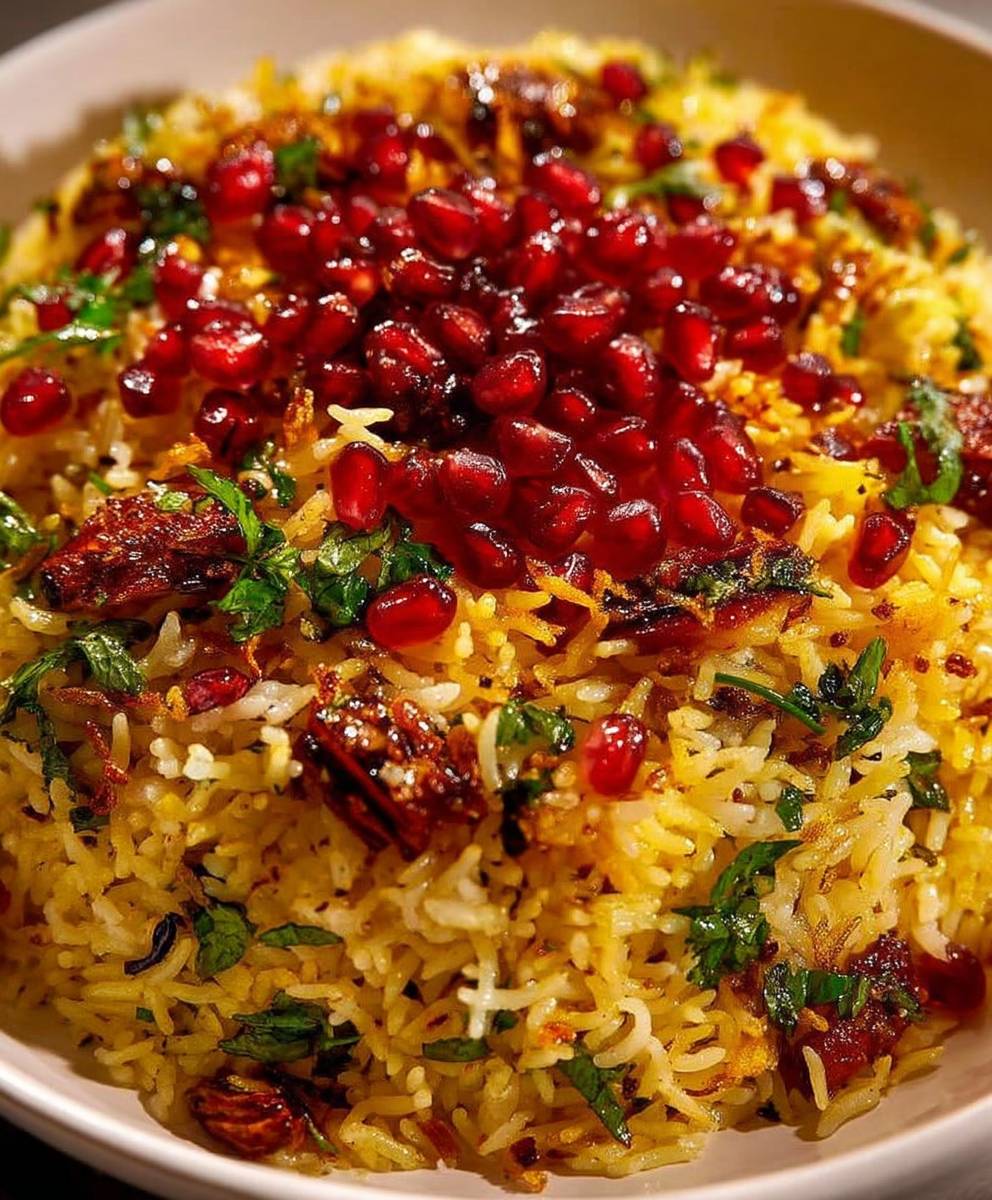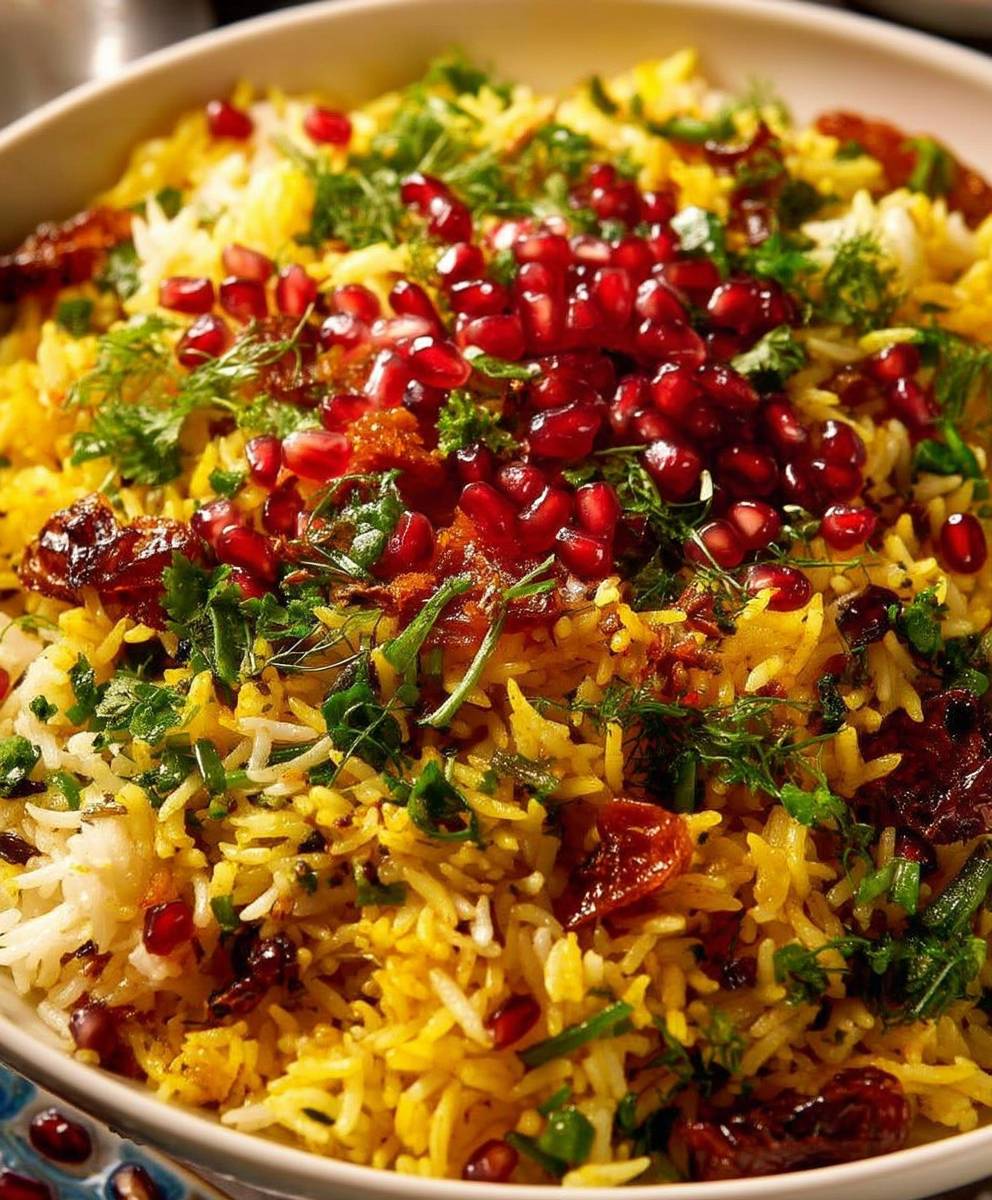Jewelled Rice Pilaf Easter is more than just a side dish; it’s a vibrant celebration on a plate! Imagine a fluffy bed of perfectly cooked rice, studded with glistening jewels of dried fruit and crunchy nuts, each bite a delightful explosion of textures and flavors. This isn’t your average rice; it’s a showstopper, guaranteed to impress your guests this Easter.
The concept of “jewelled rice” has roots in Persian cuisine, where it’s known as Javaher Polow. Traditionally, it’s served at special occasions like weddings and celebrations, symbolizing prosperity and good fortune. The vibrant colors and rich ingredients represent the abundance of life, making it a perfect fit for the joyous spirit of Easter.
What makes Jewelled Rice Pilaf Easter so irresistible? Beyond its stunning appearance, it’s the harmonious blend of sweet and savory notes. The sweetness of the dried cranberries, apricots, and raisins is perfectly balanced by the nutty crunch of pistachios and almonds. The aromatic spices, like cardamom and saffron, add a warm and inviting fragrance that fills your kitchen. Plus, it’s surprisingly easy to make! You can prepare many of the components ahead of time, leaving you free to enjoy the Easter festivities. Its a dish that elevates any meal, adding a touch of elegance and exotic flair. I know you and your family will love this vibrant and flavorful addition to your Easter table!

Ingredients:
- 2 tablespoons olive oil
- 1 large onion, finely chopped
- 2 cloves garlic, minced
- 1 cup basmati rice, rinsed thoroughly
- 2 cups vegetable broth (or chicken broth for a richer flavor)
- 1/2 teaspoon saffron threads, steeped in 2 tablespoons hot water
- 1/4 cup dried cranberries
- 1/4 cup golden raisins
- 1/4 cup dried apricots, chopped
- 1/4 cup pistachios, shelled and roughly chopped
- 1/4 cup almonds, slivered
- 1/4 cup fresh parsley, chopped
- 1/4 cup fresh cilantro, chopped
- 2 tablespoons butter
- 1/4 teaspoon ground cardamom
- 1/4 teaspoon ground cinnamon
- Salt and freshly ground black pepper to taste
- 1/4 cup pomegranate seeds (for garnish)
- Lemon wedges (for serving, optional)
Preparing the Rice and Aromatics
- Sauté the Aromatics: Heat the olive oil in a large, heavy-bottomed pot or Dutch oven over medium heat. Add the chopped onion and cook until softened and translucent, about 5-7 minutes. Stir frequently to prevent burning.
- Add Garlic: Add the minced garlic to the pot and cook for another minute, until fragrant. Be careful not to burn the garlic, as it can become bitter.
- Toast the Rice: Add the rinsed basmati rice to the pot and stir to coat it well with the oil and aromatics. Toast the rice for 2-3 minutes, stirring constantly. This step helps to enhance the flavor of the rice and prevent it from becoming sticky. You’ll notice the rice grains becoming slightly translucent.
Cooking the Pilaf
- Add Broth and Saffron: Pour in the vegetable broth (or chicken broth) and the saffron water (including the saffron threads). Stir well to combine.
- Season and Simmer: Season with salt, pepper, cardamom, and cinnamon. Bring the mixture to a boil, then reduce the heat to low, cover the pot tightly, and simmer for 18-20 minutes, or until the rice is cooked through and the liquid is absorbed. It’s crucial to keep the lid on tightly during this step to ensure the rice steams properly. Avoid lifting the lid to check on the rice, as this can release steam and affect the cooking time.
- Check for Doneness: After 18 minutes, check the rice. If the liquid is absorbed and the rice is tender, proceed to the next step. If there’s still liquid in the pot, continue to simmer for a few more minutes, checking periodically until the liquid is absorbed. If the rice is still too firm and the liquid is gone, add a tablespoon or two of broth and continue simmering.
Adding the Jeweled Elements
- Fluff the Rice: Once the rice is cooked, remove the pot from the heat and let it stand, covered, for 5-10 minutes. This allows the steam to redistribute and the rice to become even more fluffy. After resting, fluff the rice gently with a fork.
- Melt the Butter: While the rice is resting, melt the butter in a small saucepan over low heat.
- Incorporate Dried Fruits and Nuts: Add the dried cranberries, golden raisins, dried apricots, pistachios, and almonds to the pot with the rice. Pour the melted butter over the top.
- Gently Fold: Gently fold the dried fruits, nuts, and butter into the rice, being careful not to overmix and crush the rice grains.
- Add Fresh Herbs: Stir in the chopped parsley and cilantro.
Final Touches and Serving
- Garnish: Transfer the jeweled rice pilaf to a serving dish. Garnish with pomegranate seeds for a pop of color and a burst of fresh, tart flavor.
- Serve: Serve the jeweled rice pilaf warm. It’s a beautiful and flavorful side dish that’s perfect for Easter or any special occasion.
- Optional: Serve with lemon wedges for those who like a touch of acidity. The lemon juice brightens the flavors of the pilaf.
Tips for Success:
- Rinse the Rice: Rinsing the basmati rice thoroughly before cooking is essential for removing excess starch, which helps to prevent the rice from becoming sticky. Rinse the rice under cold running water until the water runs clear.
- Use Good Quality Broth: The quality of the broth you use will significantly impact the flavor of the pilaf. Use a good quality vegetable broth or chicken broth for the best results. Homemade broth is always a great option if you have the time.
- Don’t Overcook the Rice: Overcooked rice can become mushy and unappetizing. Be sure to check the rice for doneness after 18 minutes of simmering and adjust the cooking time as needed.
- Toast the Nuts: For an even more intense nutty flavor, you can toast the pistachios and almonds in a dry skillet over medium heat for a few minutes before adding them to the pilaf. Watch them carefully, as they can burn easily.
- Adjust Sweetness: If you prefer a less sweet pilaf, you can reduce the amount of dried fruit. You can also use different types of dried fruit, such as currants or chopped dates.
- Make it Vegan: To make this recipe vegan, simply use vegetable broth and ensure that the butter is replaced with a vegan butter substitute or an additional tablespoon of olive oil.
- Spice it Up: For a little extra warmth, add a pinch of red pepper flakes to the pilaf along with the cardamom and cinnamon.
- Make Ahead: The jeweled rice pilaf can be made ahead of time and reheated. Prepare the pilaf according to the recipe instructions, then let it cool completely. Store it in an airtight container in the refrigerator for up to 2 days. To reheat, gently warm the pilaf in a saucepan over low heat, adding a tablespoon or two of broth if needed to prevent it from drying out. You can also reheat it in the microwave.
- Serving Suggestions: This jeweled rice pilaf is a versatile side dish that pairs well with a variety of main courses. It’s especially delicious with roasted lamb, chicken, or fish. It also makes a great addition to a vegetarian or vegan meal. Consider serving it alongside a lentil stew or a roasted vegetable platter.
Variations:
- Citrus Zest: Add the zest of one orange or lemon to the pilaf along with the dried fruits and nuts for a bright, citrusy flavor.
- Fresh Herbs: Experiment with different fresh herbs, such as mint, dill, or chives.
- Vegetables: Add cooked vegetables, such as peas, carrots, or green beans, to the pilaf for added nutrition and flavor.
- Spices: Adjust the spices to your liking. You can add other spices, such as cumin, coriander, or turmeric.
- Nuts: Use different types of nuts, such as walnuts, pecans, or cashews.
Why This Recipe Works:
This recipe works because it combines the fragrant flavors of basmati rice, saffron, and spices with the sweetness of dried fruits and the crunch of nuts. The toasting of the rice and the use of good quality broth enhance the flavor of the pilaf, while the fresh herbs add a touch of brightness. The pomegranate seeds provide a beautiful garnish and a burst of fresh, tart flavor. The recipe is also relatively easy to make and can be adapted to suit your personal preferences. The key is to use high-quality ingredients and to follow the instructions carefully. By rinsing the rice, toasting it, and simmering it properly, you can create a delicious and flavorful jeweled rice pilaf that is sure to impress your guests. The balance of sweet, savory, and nutty flavors makes this dish a crowd-pleaser, and the vibrant colors make it a visually stunning addition to any table.

Conclusion:
This Jewelled Rice Pilaf isn’t just a side dish; it’s a vibrant celebration on a plate, and trust me, you absolutely have to try it! The combination of fluffy rice, sweet dried fruits, crunchy nuts, and fragrant spices creates a symphony of textures and flavors that will elevate any meal, especially your Easter feast. It’s a dish that’s both visually stunning and incredibly delicious, making it a guaranteed crowd-pleaser.
Think of it: the glistening jewels of cranberries and apricots nestled amongst the golden almonds and pistachios, all resting on a bed of perfectly cooked rice. It’s a feast for the eyes as much as it is for the palate. And the best part? It’s surprisingly easy to make! Don’t let the fancy name intimidate you. With just a few simple steps, you can create a dish that looks and tastes like it came straight from a gourmet restaurant.
But the real magic of this Jewelled Rice Pilaf lies in its versatility. While it’s perfect as a side dish for your Easter ham, roast lamb, or even a vegetarian main course, it’s also fantastic served cold as a rice salad. You can even add grilled chicken or shrimp for a complete and satisfying meal.
Serving Suggestions and Variations:
* For a vegetarian option: Serve alongside roasted vegetables like asparagus, Brussels sprouts, or carrots. A dollop of creamy yogurt or a sprinkle of feta cheese adds a tangy counterpoint to the sweetness of the dried fruits.
* Spice it up: Add a pinch of cayenne pepper or a dash of harissa paste for a subtle kick.
* Go nuts: Experiment with different nuts like walnuts, pecans, or cashews. Toasting the nuts beforehand enhances their flavor and adds extra crunch.
* Fruit forward: Use different dried fruits like golden raisins, dates, or figs. You can also add fresh fruits like pomegranate seeds or orange segments for a burst of freshness.
* Herb heaven: Fresh herbs like parsley, cilantro, or mint add a bright and aromatic touch.
* Lemon zest: A little lemon zest brightens the flavors and adds a zesty note.
* Make it ahead: You can prepare the rice pilaf a day in advance and reheat it before serving. Just add a little water or broth to prevent it from drying out.
This recipe is more than just a set of instructions; it’s an invitation to get creative in the kitchen and make it your own. Don’t be afraid to experiment with different ingredients and flavors to create a dish that perfectly suits your taste.
I truly believe that this Jewelled Rice Pilaf will become a staple in your recipe repertoire. It’s a dish that’s perfect for special occasions, but it’s also easy enough to make for a weeknight dinner. It’s a guaranteed crowd-pleaser that will impress your family and friends.
So, what are you waiting for? Gather your ingredients, put on some music, and get cooking! I’m confident that you’ll love this recipe as much as I do. And when you do, please come back and share your experience in the comments below. I’d love to hear how it turned out and any variations you made. Happy cooking, and happy Easter! I can’t wait to see your beautiful creations! Let me know if you have any questions, and I’ll be happy to help. Enjoy this delicious and festive dish!
Jewelled Rice Pilaf Easter: A Festive & Flavorful Recipe
Fragrant and colorful Jeweled Rice Pilaf, a delightful blend of basmati rice, saffron, dried fruits, nuts, and fresh herbs. Perfect for special occasions!
Ingredients
- 2 tablespoons olive oil
- 1 large onion, finely chopped
- 2 cloves garlic, minced
- 1 cup basmati rice, rinsed thoroughly
- 2 cups vegetable broth (or chicken broth for a richer flavor)
- 1/2 teaspoon saffron threads, steeped in 2 tablespoons hot water
- 1/4 cup dried cranberries
- 1/4 cup golden raisins
- 1/4 cup dried apricots, chopped
- 1/4 cup pistachios, shelled and roughly chopped
- 1/4 cup almonds, slivered
- 1/4 cup fresh parsley, chopped
- 1/4 cup fresh cilantro, chopped
- 2 tablespoons butter
- 1/4 teaspoon ground cardamom
- 1/4 teaspoon ground cinnamon
- Salt and freshly ground black pepper to taste
- 1/4 cup pomegranate seeds (for garnish)
- Lemon wedges (for serving, optional)
Instructions
- Sauté the Aromatics: Heat the olive oil in a large, heavy-bottomed pot or Dutch oven over medium heat. Add the chopped onion and cook until softened and translucent, about 5-7 minutes. Stir frequently to prevent burning.
- Add Garlic: Add the minced garlic to the pot and cook for another minute, until fragrant. Be careful not to burn the garlic, as it can become bitter.
- Toast the Rice: Add the rinsed basmati rice to the pot and stir to coat it well with the oil and aromatics. Toast the rice for 2-3 minutes, stirring constantly. This step helps to enhance the flavor of the rice and prevent it from becoming sticky. You’ll notice the rice grains becoming slightly translucent.
- Add Broth and Saffron: Pour in the vegetable broth (or chicken broth) and the saffron water (including the saffron threads). Stir well to combine.
- Season and Simmer: Season with salt, pepper, cardamom, and cinnamon. Bring the mixture to a boil, then reduce the heat to low, cover the pot tightly, and simmer for 18-20 minutes, or until the rice is cooked through and the liquid is absorbed. It’s crucial to keep the lid on tightly during this step to ensure the rice steams properly. Avoid lifting the lid to check on the rice, as this can release steam and affect the cooking time.
- Check for Doneness: After 18 minutes, check the rice. If the liquid is absorbed and the rice is tender, proceed to the next step. If there’s still liquid in the pot, continue to simmer for a few more minutes, checking periodically until the liquid is absorbed. If the rice is still too firm and the liquid is gone, add a tablespoon or two of broth and continue simmering.
- Fluff the Rice: Once the rice is cooked, remove the pot from the heat and let it stand, covered, for 5-10 minutes. This allows the steam to redistribute and the rice to become even more fluffy. After resting, fluff the rice gently with a fork.
- Melt the Butter: While the rice is resting, melt the butter in a small saucepan over low heat.
- Incorporate Dried Fruits and Nuts: Add the dried cranberries, golden raisins, dried apricots, pistachios, and almonds to the pot with the rice. Pour the melted butter over the top.
- Gently Fold: Gently fold the dried fruits, nuts, and butter into the rice, being careful not to overmix and crush the rice grains.
- Add Fresh Herbs: Stir in the chopped parsley and cilantro.
- Garnish: Transfer the jeweled rice pilaf to a serving dish. Garnish with pomegranate seeds for a pop of color and a burst of fresh, tart flavor.
- Serve: Serve the jeweled rice pilaf warm. It’s a beautiful and flavorful side dish that’s perfect for Easter or any special occasion.
- Optional: Serve with lemon wedges for those who like a touch of acidity. The lemon juice brightens the flavors of the pilaf.
Notes
- Rinsing the basmati rice thoroughly before cooking is essential for removing excess starch, which helps to prevent the rice from becoming sticky. Rinse the rice under cold running water until the water runs clear.
- Use good quality vegetable broth or chicken broth for the best results. Homemade broth is always a great option if you have the time.
- Don’t Overcook the Rice: Overcooked rice can become mushy and unappetizing. Be sure to check the rice for doneness after 18 minutes of simmering and adjust the cooking time as needed.
- For an even more intense nutty flavor, you can toast the pistachios and almonds in a dry skillet over medium heat for a few minutes before adding them to the pilaf. Watch them carefully, as they can burn easily.
- If you prefer a less sweet pilaf, you can reduce the amount of dried fruit. You can also use different types of dried fruit, such as currants or chopped dates.
- To make this recipe vegan, simply use vegetable broth and ensure that the butter is replaced with a vegan butter substitute or an additional tablespoon of olive oil.
- For a little extra warmth, add a pinch of red pepper flakes to the pilaf along with the cardamom and cinnamon.
- The jeweled rice pilaf can be made ahead of time and reheated. Prepare the pilaf according to the recipe instructions, then let it cool completely. Store it in an airtight container in the refrigerator for up to 2 days. To reheat, gently warm the pilaf in a saucepan over low heat, adding a tablespoon or two of broth if needed to prevent it from drying out. You can also reheat it in the microwave.
- This jeweled rice pilaf is a versatile side dish that pairs well with a variety of main courses. It’s especially delicious with roasted lamb, chicken, or fish. It also makes a great addition to a vegetarian or vegan meal. Consider serving it alongside a lentil stew or a roasted vegetable platter.



Leave a Comment